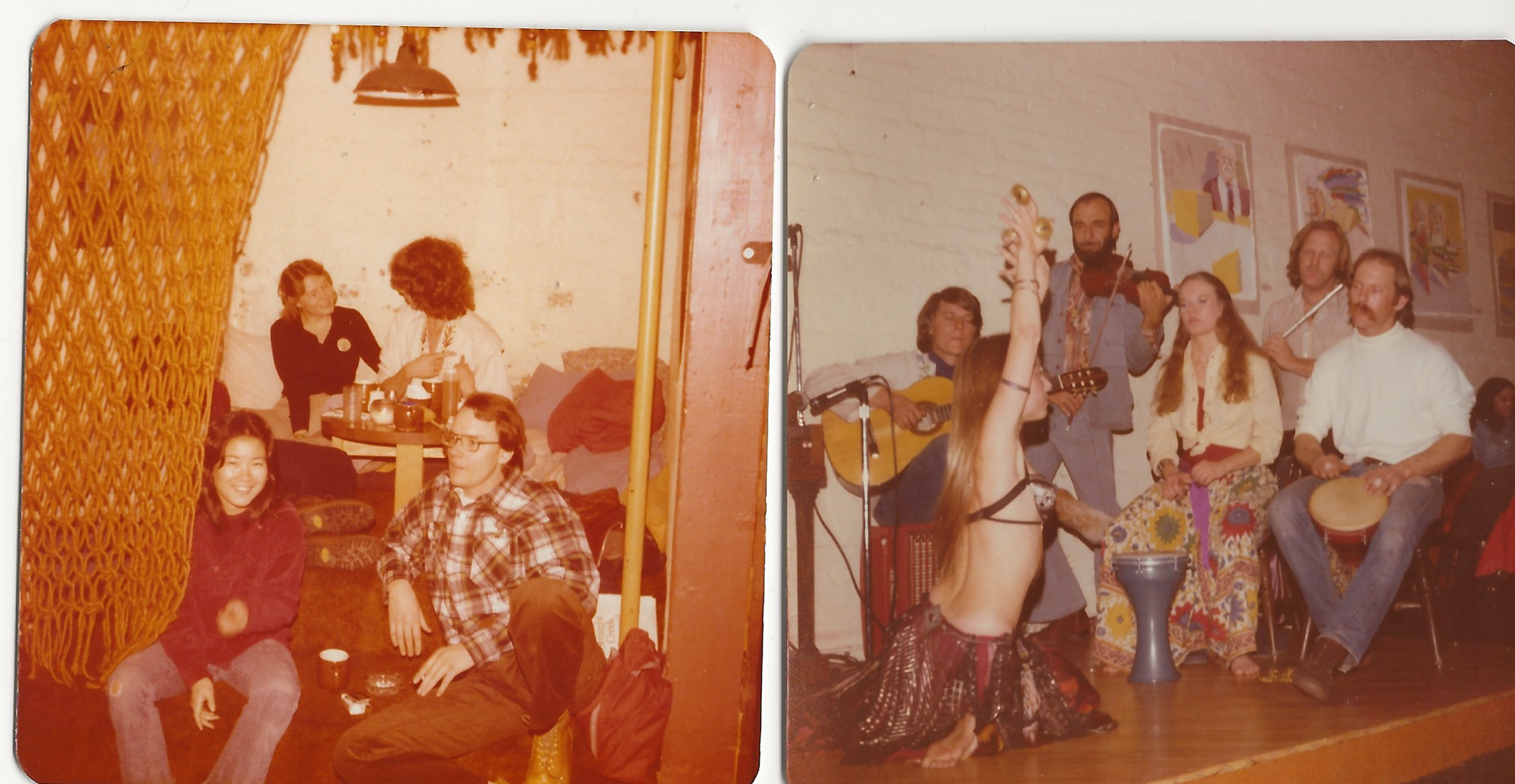
Courtesy of Diane Lomonaco

Audio By Carbonatix
In the past two decades, Denver has undergone a caffeinated revolution, evolving from a modest (yet sprightly) coffee scene to becoming an award-winning coffee city. Local roasters like Corvus, Novo, Sweet Bloom and Huckleberry have swept through the city, touting single-origin craft beans and elevating both the taste and the production of coffee options in the Mile High.
Yet no latte aficionado can forget the city’s classic coffeehouses – institutions unto themselves – like St. Mark’s, Pablo’s on 6th and Stella’s Coffee Haus. While they might not be roasting their own beans on site, each is grounded in its own eclectic personality and offers its customers a place to gather.
Such shops are reminiscent of Denver’s first coffee revolution in the 1970s, when a trio of oddball cafes – the Mercury Cafe, Muddy Waters on the Platte Coffeehouse and Café Nepenthes – sought to redefine coffee, community and a collective identity centered on talking over a cup of joe.
“We were hippies,” says Marilyn Megenity, who owned and ran the Mercury for 46 years. “We felt like a better world was coming, and that we were agents of that,” she adds, framing Muddy’s, Nepenthes and the Merc as having a “symbiotic” relationship.
I grew up on stories from this period, as my Aunt Diane and Uncle Stan ran the bohemian, all-natural Café Nepenthes at 1416 Market Street (right across the street from Westword‘s first office) from 1976 to 1982.
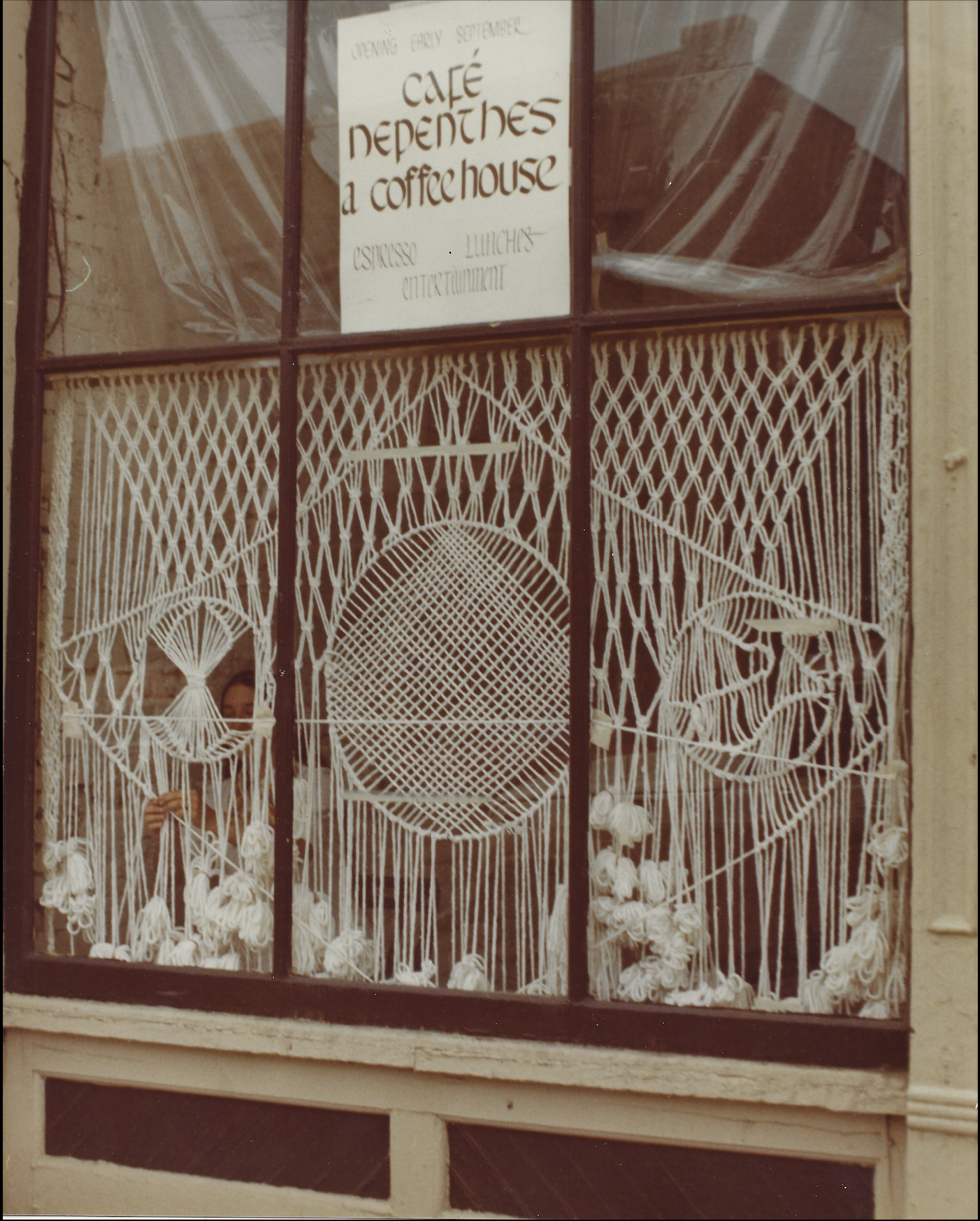
Diane Lomonaco braiding macramé for the cafe’s opening.
Courtesy of Diane Lomonaco
They salvaged everything they could. Snakeskin lamps with frayed, crisp wiring hung from the ceiling. An empty elevator shaft in the corner was converted into a pillowed leisure area aptly named “The Shaft.” Oak doors from when the building was a poultry store opened to a white interior, with grimy blue shag carpet covering the most uneven patches of the old warehouse floor. A low, round table across from the stage with Moroccan-style ground seating was dubbed “The Fez.” The air was thick with spices and the smell of the house blends of espresso, at a time when most Denverites’ definition of coffee didn’t expand past a can of Folgers.
Diane Schaefer (now Lomonaco) was 24, pregnant, and driving a school bus when she opened Café Nepenthes in 1976 with her husband, Stan Schaefer, and two other business partners. After studying at the University of Colorado Boulder, the Schaefers met David Praver while working in the kitchen at the Ramada Inn. Their other partner, Brian Keating, who was a former student at a free high school that Praver had founded, was around nineteen years old.
“Coffeehouses were pretty few and far between,” says Lomonaco while flipping through a photo album of the cafe. “[There weren’t] places that were open late and had a non-bar atmosphere. Places where people could gather and talk.”
Borrowing a thousand dollars here and there “from whoever would believe us,” as Lomonaco puts it, Café Nepenthes began collecting its eclectic community. Artists, poets, hippies, belly dancers, musicians and restless youth found a lively meeting place tucked between the warehouses, parking lots and viaducts that dominated lower downtown, as it was called then.
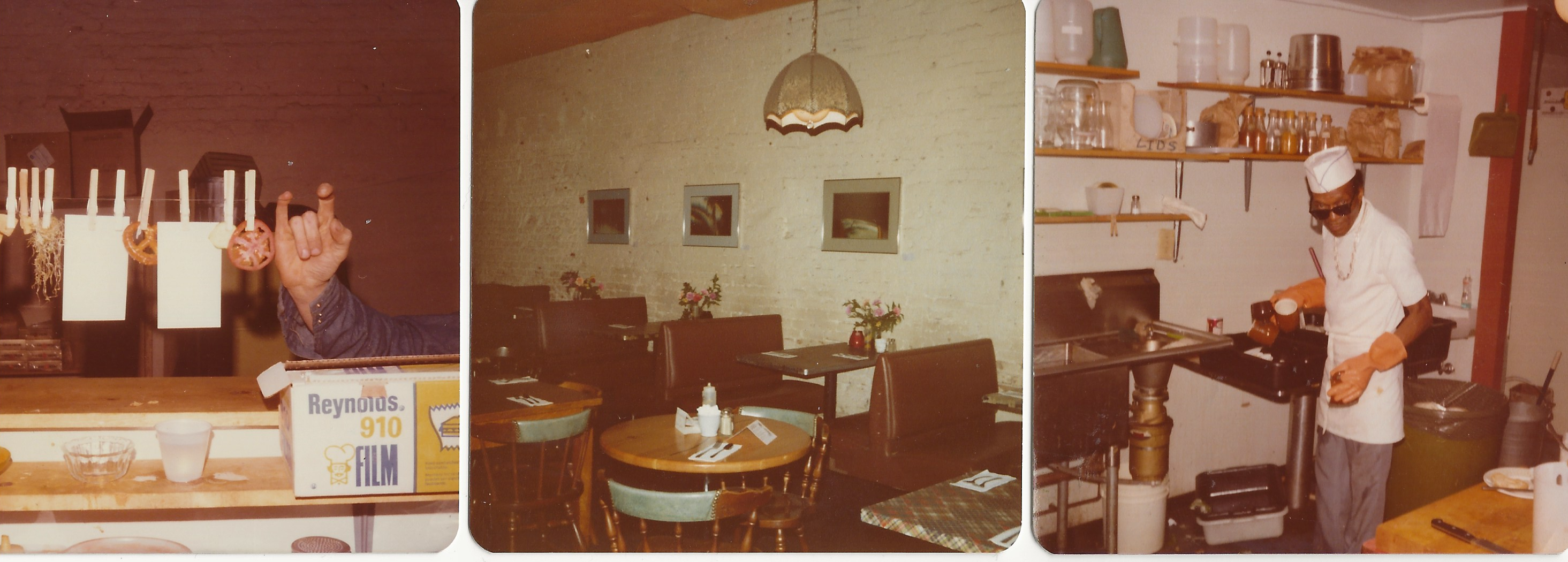
Assorted foods hanging on the ticket line; the cafe’s booths and snakeskin lamps; Jimmy the dishwasher.
Courtesy of Diane Lomonaco
There was Jimmy the dishwasher, who always wore sunglasses, dressed in drag when drinking and maintained two identical tubs of greasy soap water – one for the clean plates and one for the dirty, but no one could tell which was which. Or Stephen, who sat in his booth nursing a single cup of coffee for the entire day as he worked on yet another volume of his sprawling self-published memoir, Man, God and The Universe.
Stan Schaefer points to Denver’s beatnik cafes from the ’50s and early ’60s as the source of inspiration for Nepenthes, back when Jack Kerouac and Allen Ginsberg frequented joints like the Green Spider on 17th Avenue and Café Tarot on 20th Street.
“We viewed a coffeehouse as kind of a radical step. It was a place to talk about the world, innovation – how things might be different,” says Schaefer.
Praver, despite not knowing much about cooking, led the charge for a restaurant that would serve only organic and healthy dishes. Keating invented all of the tea blends they used. Schaefer and Lomonaco manned the kitchen.
Lacking a stove, they got by with soup pots and a toaster oven to make some of their classic sandwiches, including the Chile Jack, which had melted Monterey Jack cheese, grilled green chiles, mustard and onions, and, like every item on the menu, was topped with a generous pile of sprouts. Dishes were vegetarian except for a single turkey sandwich, which was added only after deep contemplation and several heated debates among the owners.
Word on the street was to avoid the drip coffee at all costs, but the espresso and specialty drinks were the crème de la crème. Best sellers like the Café Diane (coffee with chocolate shavings) or the Orange Stanley (a shake made from orange juice, protein powder and ice cream) were part of the expansive drink menu.
For some, the cafe was too radical. “No one knew what hummus was,” Lomonaco says. “We had a hummus plate and pita bread and stuff that people were like, ‘What the hell is this?'”
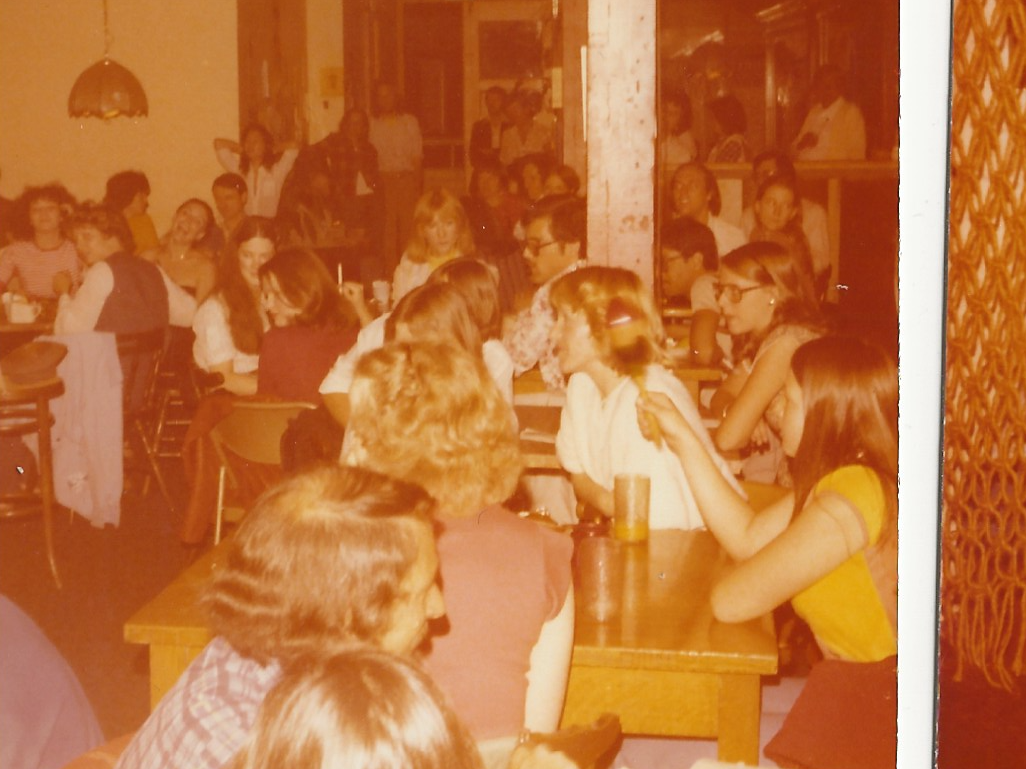
A full house for a show at Café Nepenthes.
Courtesy of Diane Lomonaco
Beyond the food, there was the stage.
Schaefer and Praver loaded up as much of the Trocadero Ballroom stage from Elitch Gardens as they could carry. The 150-year-old ballroom had provided a cheap safe haven for Depression-era teens to dance; at Nepenthes, they rebuilt the maple boards into a new stage, and the wood once again felt the thumping of feet.
Live acoustic duos, folk bands and experimental jazz artists played night after night for tips alone, as the cafe couldn’t pay them directly. Whether it was Dolomite, the piano player who played with Jerry Garcia and drank white port and lemon juice with employees in the back, or members of jazz vocal group the New York Voices, sets often packed the cafe to capacity.
Customer-turned-employee Michael Klahr and Beat poet Ed Ward started Monday poetry nights, which accepted the avant-garde and amateur alike. Frank Winters, a bully of a poet that the owners always made read last (to clear the place out at closing time) wore a leather trench coat and towered above his audience at six feet, six inches. One time, after a dispute with another customer, Winters ran to the kitchen, grabbed forks that he bent around his fingers, and prepared to go down fighting before being kicked to the curb by the working manager.
Like anything else, the cafe was dependent on its people and could only stay open as long as its foundation remained intact. Brian Keating left before the first year was through, followed by Praver, who became a spiritual leader at a commune in California.
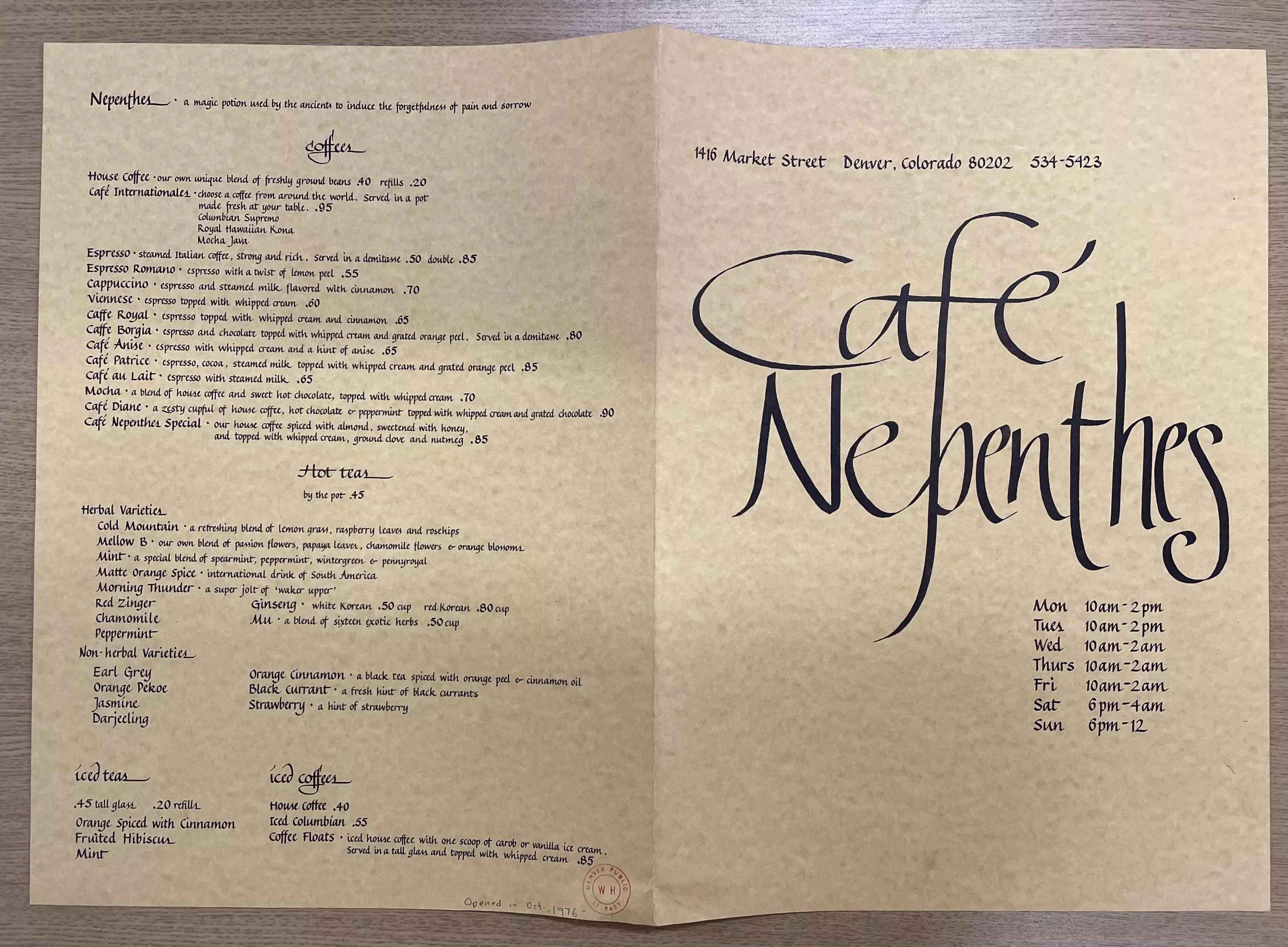
A copy of a Café Nepenthes menu from the Denver Public Library’s archives.
Peter Jonas
Schaefer, under the high demands of keeping a restaurant in business, left as the community began to change. “It existed in a time and space where it seemed like it was fun and there was a community that grew around it,” he says. “And then as times change, you know, the people that were part of the community moved on.”
Lomonaco ran the place alone for three years, enlisting the help of Klahr to manage Nepenthes when she enrolled in a master’s program for clinical psychology. Worn thin from trying to keep the cafe afloat, she describes a sense of betrayal from the customers and staff that had built a family out of the place when she told them she was selling it in 1982.
“It was heartbreaking, but I was ready,” Lomonaco recalls. “I was so exhausted.”
Despite Nepenthes being renamed by its new owners to Cafe du Monde before closing shortly after, it helped inspire other prominent Denver coffeehouses like Paris on the Platte, which stayed open from 1986 to 2015, as well as bohemian cafes that are still around today, like City, O’ City and the Bardo.
After its stint as Cafe du Monde, 1416 Market sat vacant for some time until another coffee shop, the first location of St. Mark’s Coffeehouse, opened in the 1990s. Now on East 17th, St. Mark’s carries a bit of the same eccentric style that Nepenthes did, including late hours and a funky interior, complete with a painting behind the bar reminiscent of Botticelli’s “The Birth of Venus.”
The Nepenthes community still lives on via a loose web of blogs, Facebook posts and email chains kept together by its former patrons. Forty years from its start, there are still many Nepenthians ready to jump at the chance to pull out a story about the cafe and the people that frequented its blue-shagged floors.
“Odysseus drinks a nepenthe to forget his sorrow,” Lomonaco explains when asked about the name. “It was a drug to take away your sorrows.”